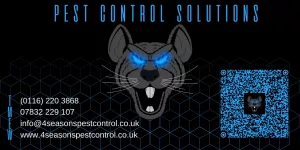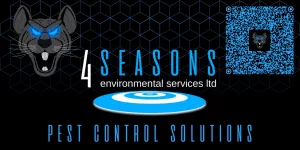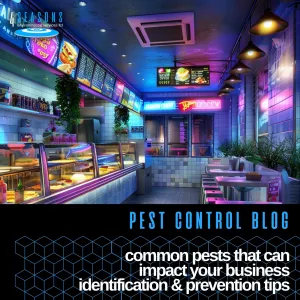Common Pests That Could Impact Your Business
Identification and Prevention Tips
by 4 Seasons Environmental Services
19 March 2024
Introduction
Pest infestations pose a significant threat to businesses, potentially causing extensive damage to property, products, and reputation. Whether it’s rodents scurrying through storage areas, cockroaches infiltrating commercial kitchens, ants marching along walls, or flies buzzing around food prep areas, the presence of pests can disrupt operations and erode customer trust. In this comprehensive guide, we’ll delve deeper into the world of common pests that could impact your business and provide detailed insights and prevention tips to help you safeguard your business operations and reputation. From identifying signs of pest activity to implementing proactive measures, we’ll equip you with the knowledge and strategies needed to effectively manage pest risks and maintain a pest-free environment within your business premises.
Rodents: A Persistent Threat to Business Operations
Rodents, including mice and rats, are ubiquitous pests that can wreak havoc on businesses of all types. Their ability to squeeze through tiny openings and their propensity for rapid reproduction make them a persistent threat to business operations. Beyond the physical damage they cause by gnawing on structures and wiring, rodents also pose significant health risks by contaminating food and surfaces with their urine, droppings, and hair.
Identifying Signs of Rodent Activity
To effectively combat rodent infestations, it’s crucial to be able to recognise the signs of their presence. Look out for droppings, which are typically small, dark, and pellet-like, as well as gnaw marks on surfaces and nesting materials such as shredded paper or fabric. Rodents also leave behind grease marks along walls and baseboards as they navigate through their environment.
Assessing Potential Risks of Rodents
The presence of rodents in a business setting can have far-reaching consequences. Beyond the physical damage they cause, rodents can also tarnish a business’s reputation and lead to costly regulatory fines or legal liabilities if their presence results in food contamination or illness among customers or employees. Moreover, the mere sight of rodents can in-still fear and disgust in customers, driving them away and impacting revenue.
Implementing Preventive Measures for Rodents
Prevention is key when it comes to managing rodent infestations. Businesses should take proactive steps to deny rodents access to their premises by sealing gaps and cracks in building exteriors, installing door sweeps and screens, and trimming back vegetation that could provide rodents with cover or access points. Inside the premises, store food and supplies in sealed containers, maintain cleanliness and sanitation, and schedule regular pest inspections and monitoring to detect and address rodent activity early on.
By adopting a proactive approach to rodent control and implementing robust preventive measures, businesses can effectively mitigate the risks associated with rodent infestations and safeguard their operations, reputation, and bottom line.
Cockroaches: Persistent Pests in Commercial Environments
Cockroaches are tenacious pests that thrive in warm, humid environments, making them a common nuisance in commercial settings such as restaurants, hotels, and food processing facilities. These resilient insects can pose serious health risks by contaminating food and surfaces with bacteria, pathogens, and allergens, potentially leading to food-borne illnesses and allergic reactions among customers and employees alike.
Identifying Signs of Cockroach Activity
Detecting the presence of cockroaches early on is crucial for effective pest management. Look out for signs such as droppings, which resemble small, dark specks or cylindrical pellets, as well as egg casings, which are typically small, brown, and oval-shaped. Cockroaches also emit a musty odour, especially in areas of heavy infestation, which can serve as an olfactory indicator of their presence.
Assessing Potential Risks of Cockroaches
Cockroach infestations can have serious consequences for businesses, ranging from contamination of food and surfaces to damage to equipment and infrastructure. In addition to the immediate health risks posed by cockroach allergens and pathogens, the presence of cockroaches can also damage a business’s reputation and lead to financial losses due to customer complaints, negative reviews, and regulatory penalties.
Implementing Preventive Measures for Cockroaches
Preventing cockroach infestations requires a multifaceted approach that addresses conducive conditions and entry points while also implementing proactive control measures. Businesses should maintain cleanliness and sanitation, paying special attention to areas such as kitchens, food storage areas, and garbage disposal areas. Seal cracks and crevices in walls, floors, and cabinets to deny cockroaches access, and store food in tightly sealed containers to eliminate potential food sources.
Regular inspections and monitoring are essential for early detection of cockroach activity, allowing businesses to take swift action before infestations escalate. Implementing integrated pest management (IPM) strategies that combine sanitation, exclusion, and targeted treatments can help businesses effectively manage cockroach populations and maintain a pest-free environment within their premises.
Ants: Persistent Foragers in Business Environments
Ants are common pests that can infiltrate businesses in search of food, water, and shelter. While individual ants may seem harmless, large colonies can quickly establish themselves within commercial premises, posing a threat to hygiene standards and customer satisfaction. Understanding the behaviour and habits of ants is essential for effective ant management in business environments.
Identifying Signs of Ant Activity
Ants leave behind visible signs of their presence, including trails along walls and floors, small piles of debris near entry points, and sometimes, the insects themselves. Identifying the species of ant present can also provide valuable insights into their behaviour and potential nesting sites. Common ant species encountered in businesses include pavement ants, pharaoh ants, and odorous house ants.
Assessing Potential Risks of Ants
Ant infestations can lead to a variety of problems for businesses, ranging from contamination of food and surfaces to structural damage caused by nesting activities. Additionally, certain ant species, such as pharaoh ants, have been known to spread pathogens and contribute to the transmission of diseases in healthcare settings. Moreover, the sight of ants crawling around can be off-putting to customers and may tarnish a business’s reputation.
Implementing Preventive Measures for Ants
Preventing ant infestations requires a combination of sanitation, exclusion, and targeted treatments. Businesses should maintain cleanliness and hygiene standards, paying special attention to areas where food is stored, prepared, or consumed. Keep food in tightly sealed containers, clean up spills promptly, and eliminate sources of standing water both indoors and outdoors.
Sealing cracks and gaps in building exteriors, as well as repairing damaged window screens and door sweeps, can help prevent ants from gaining entry into the premises. Additionally, implementing landscaping practices that discourage ant nesting, such as trimming vegetation away from the building and removing debris and organic matter from the surrounding area, can further reduce the risk of infestation.
Regular inspections and monitoring are essential for early detection of ant activity, allowing businesses to implement timely interventions before infestations escalate. Integrated pest management (IPM) strategies that combine preventive measures with targeted treatments can help businesses effectively manage ant populations and maintain a pest-free environment within their premises.
Flies: Nuisance Pests in Business Environments
Flies, including house flies and fruit flies, are common pests that can be found in various commercial settings, including restaurants, grocery stores, and food processing facilities. These flying insects not only pose a nuisance to customers and employees but also present serious health risks by contaminating food and surfaces with bacteria and pathogens.
Identifying Signs of Fly Activity
Detecting signs of fly activity early on is crucial for effective pest management. Look out for swarms of flies, particularly around food sources or waste disposal areas, as well as the presence of fly larvae or maggots, which may indicate breeding sites nearby. Fly specks, which are small black or brown spots on surfaces, can also serve as indicators of fly activity.
Assessing Potential Risks of Flies
Fly infestations can have serious consequences for businesses, ranging from food contamination to regulatory violations and customer complaints. Flies are known vectors of various pathogens, including Salmonella, E. coli, and Staphylococcus, which can cause food-borne illnesses in humans. Moreover, the mere presence of flies can create an unsanitary and unappealing environment, leading to loss of customer trust and revenue.
Implementing Preventive Measures for Flies
Preventing fly infestations requires a proactive approach that addresses conducive conditions and potential breeding sites. Businesses should implement proper sanitation practices, including regular cleaning and disinfection of food preparation areas, garbage bins, and drains. Dispose of organic waste promptly and ensure that garbage bins are tightly sealed to prevent access by flies.
Installing screens on doors and windows can help prevent flies from entering the premises, while fly traps or electronic fly control devices can be used to capture adult flies and reduce their populations. Additionally, implementing landscaping practices that minimise standing water and organic debris around the building can help deter fly breeding.
Regular inspections and monitoring are essential for early detection of fly activity, allowing businesses to implement timely interventions before infestations escalate. Integrated pest management (IPM) strategies that combine preventive measures with targeted treatments can help businesses effectively manage fly populations and maintain a pest-free environment within their premises.
Protecting Your Business Against Pest Threats Conclusion
In conclusion, safeguarding your business against common pests requires vigilance, proactive measures, and a comprehensive understanding of pest behaviour and management strategies. From rodents and cockroaches to ants and flies, each pest presents unique challenges that can disrupt operations, compromise hygiene standards, and damage your business’s reputation.
By identifying signs of pest activity early on and implementing preventive measures, businesses can effectively mitigate the risks associated with pest infestations and maintain a pest-free environment within their premises. Regular inspections and monitoring play a crucial role in early detection, allowing businesses to take swift action before infestations escalate and cause significant damage.
Integrated pest management (IPM) strategies that combine sanitation, exclusion, and targeted treatments offer a holistic approach to pest control, addressing underlying causes and reducing reliance on chemical pesticides. By integrating preventive measures into daily operations and fostering a culture of cleanliness and hygiene among employees, businesses can create an inhospitable environment for pests and minimise the likelihood of infestations.
Furthermore, partnering with a reputable pest management provider can provide businesses with access to expert knowledge, innovative technologies, and tailored solutions to address specific pest challenges. By collaborating with professionals who understand the unique requirements of commercial environments, businesses can ensure effective pest control measures that protect their operations, reputation, and bottom line.
In today’s competitive business landscape, maintaining a pest-free environment is not just a matter of compliance but also a critical component of customer satisfaction and business success. By prioritising pest management as an integral part of their operations, businesses can create a safe, clean, and welcoming environment for customers and employees alike, enhancing their reputation and fostering long-term success.

© Copyright 2024 by 4 Seasons Environmental Services. All Rights Reserved.









